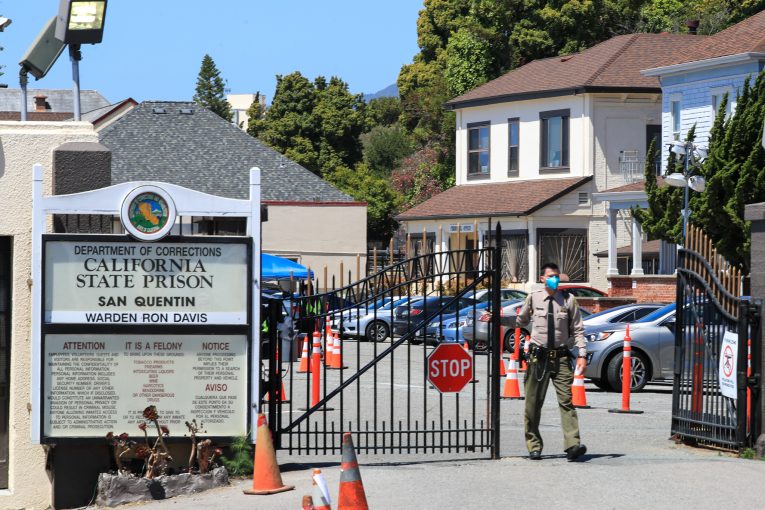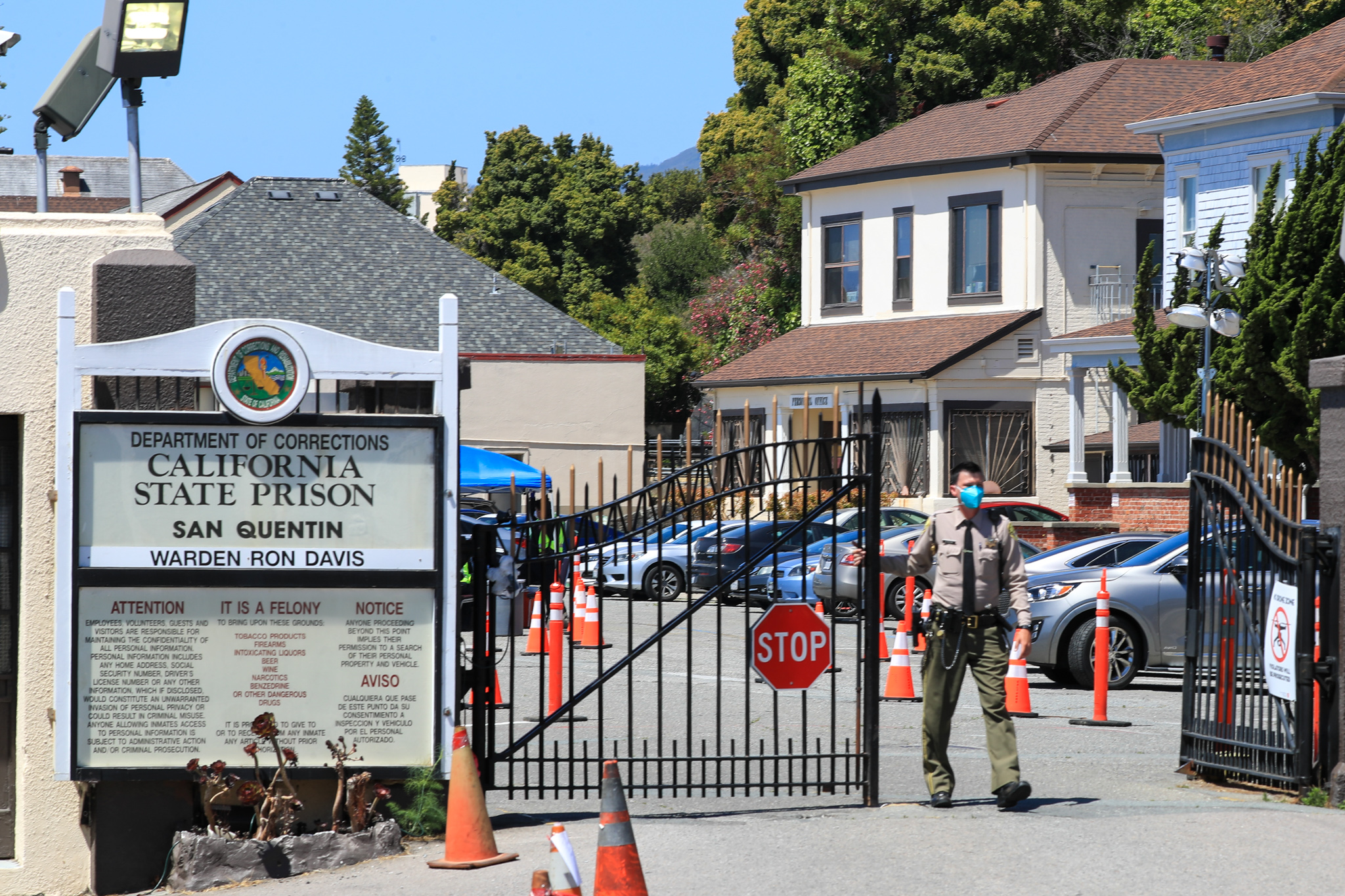


By Joan Parkin
The success of Governor Newsom’s plans to reform San Quentin into the California Model with the 380 million he is requesting from the state may rest with a little-known group of incarcerated individuals named The People In Blue (TPIB). Geared up after decades in prison working on reforms, these prisoners have organized themselves to work collaboratively with Newsom’s high-profile San Quentin Transformation Advisory Council to offer a way forward for his plan to redesign San Quentin into a rehabilitation center.
Although Newsom’s Advisory Council is chock full of leaders from California’s prison reform movement it does not contain anyone incarcerated. The TPIB maintains that a person who has not been incarcerated cannot possibly understand the changes that will need to take place in order to turn San Quentin from a retributive prison into a true rehabilitative center. They would have no idea about the programming needed to meet the needs of the 4,000 prisoners currently housed in the 170-year-old prison. In their call to action, they insist, “The dynamics of rehabilitation in action, and how to foster a rehabilitative environment, can only come from the stakeholders who have never been consulted on the issue; The incarcerated people doing the work.”
The People in Blue are a group of incarcerated people who represent the idea that the California prison system is broken and pose solutions for fixing the problem. They  state, “We are not representing the incarcerated population. We are representing ourselves and our lived experiences to the world and if any incarcerated person agrees with us they are free to join us. We are all stakeholders.”
state, “We are not representing the incarcerated population. We are representing ourselves and our lived experiences to the world and if any incarcerated person agrees with us they are free to join us. We are all stakeholders.”
The members of TPIB Incarceration Committee (Arthur Jackson, Steve Brooks, Tam Nguyen, Henok G. Ruffalo, and Anthony (Tony) Tafoya) have 107 years of incarceration experience. They have engaged in, established, and/or facilitated extensive rehabilitation groups, programs, and/or curriculum to help incarcerated people heal. Moreover, they have consistently challenged conditions within CDCR that did not support the restorative justice approach, rehabilitation, and healing of the incarcerated person.
Newsom needs all the help he can get. Two months after he introduced the plan to transform San Quentin into a Scandinavian design prison, lawmakers are pushing back hard saying his ideas lack a cohesive strategy. “I try not to consider it insulting, but it’s close,” Assemblyman Tom Lackey, R-Palmdale, said at a recent budget committee hearing. “I find it to be very disturbing that we’re following a pathway where we’re being asked to fund first and answers will come later.” A post issued by the Legislative Analyst’s Office, titled May Revision Proposals to California Model and San Quentin State Prison states, “While the administration has articulated some broad approaches to pursuing the goals of the California Model, such as ‘becoming a trauma-informed organization,’ it has not identified any clear changes to policy, practice, or prison environments it deems necessary to achieve the goals.” CDCR spokesperson Terri Hardy called the criticisms “premature” and said that a newly-appointed advisory council—led by Sacramento Mayor Darrell Steinberg—was “actively working to develop recommendations to transform the prison by the end of the year.”
The only thing concrete about the Governor’s plan is to demolish an existing building and put up a rehabilitative center in its place. This idea has been met with sharp criticism by TPIB, among others, who believe it will cause “more harm than healing.” They argue serious concerns about the project because it will eliminate existing rehabilitative programs serving hundreds of incarcerated people, create hazardous conditions from the spread of asbestos, toxic mold, and lead particles, and lead to constant delays and shutdowns of prison programming due to the need to move heavy equipment. According to TPIB Vice President and San Quentin News Editor-in-Chief Steve Brooks, “The only way to truly transform prisons is by transforming relationships between prison staff and the incarcerated population. A building isn’t going to do anything but add more space to cage people in overcrowded squalid conditions.”
In short, the TPIB asks what a building can do to fix a broken system. They do not believe that building more prisons is the way to implement the California Model. Instead, they have introduced ten key things that can be done to shift the culture inside of prison and make prisons less toxic and trauma-inducing.
In a proposal to the Advisory Council, they suggest the following: eliminate overcrowding, expedite volunteer gate clearance process, remove or do not implement any crime exclusion criteria for the California Model, open program including showers until 9:00 pm, conduct a massive cleaning of each building, create institutional constituency, remove all restrictions on healthy food items in the vendor package, expand, add, and/or increase SQ’s APPS (“Authorized Personal Property Schedule”) to allow incarcerated people access to healthy food items from health food vendors, open SQ gym and add machine weights and stationary bikes for use by the incarcerated population and officers, have ongoing Town Hall style forums for both officers and incarcerated people to announce new and/or potential program/rule changes, as well as to receive questions and/or advice to better existing programs.
While by no means exhaustive, TPIB believes that these changes are essential to create a smooth transition into the California Model. They are aimed at reducing the anxiety of the incarcerated by promoting positive physical and mental health and creating a community with officers’ and incarcerated people’s buy-in. In a press release titled “We Don’t Need New Buildings, We Need a New Culture,” TPIB states that they wholeheartedly support rehabilitation and healing for the incarcerated, victims, survivors, and families impacted by crime. They want to help facilitate a healthy and safe environment conducive to getting people home. They insist that “we can do so safely and efficiently without building new prison infrastructures and by instead building a new culture. But we believe that as a society, we must become less reliant on cages and continue to close prisons in California.”
The Governor’s Advisory Council has opened up the opportunity for the incarcerated to work with CDCR administrators and other state department entities to bring about the type of healing necessary for a true transformation of San Quentin. To this end, they have proposed four strategic areas of focus that include orientations for officers and prisoners (that will include matters on hygiene, manners, common sense, and patience), upscaling of existing successful programs, healthy food sources, and financial literacy programs. By focusing on these strategic goals and the utilization of the 10-point plan, TPIB has designed a project that would put flesh on the bare bones of Newsom’s efforts to create the California Model.
The task before Governor Newsom is enormous. The Scandinavian model contrasts sharply with the state of San Quentin. Prisoners in SQ live on a tier with another person in a 4 by 8-foot cell designed for a single occupant. It’s so small that the person has to be on their bunk for the other one to move about. You can touch the wall with both hands outstretched. The cells have bars, so all of the noise and conversations from the housing unit come crashing in at all hours of the day and night. And while SQ has been touted for its programming, the limited slots available make it nearly impossible for most of the 4,000 occupants to access it. In addition, most correctional officers see the prisoners as numbers to be shuffled about, counted, and housed in cages. They do not see them as equals. SQ is also home to the country’s largest death row and has a long history of human rights violations.
Prisons in Norway offer conditions that contrast to SQ in every way possible. Prisoners live with open doors and rooms twice the size of the claustrophobic ones at SQ. There is programming for everyone, picnics, boat rides, and correctional officers that treat prisoners as equals. Former SQ prisoner Thanh Tran who co-founded and co-hosted a podcast called Uncuffed created a segment from an opportunity he got to tour Norway prisons. He said, “It was mind-blowing to see officers connecting with incarcerated people and treating them like humans.”
The Governor’s herculean task of turning a fortress-like institution into a scalable rehabilitative Norway-like center makes the case for the involvement of TPIB all the more necessary. Changing the culture of SQ is pivotal to the transformation process. Brooks says, “The best way to change the culture of corrections is by training officers to believe it is their job to encourage rehabilitation and to actively participate in the transformation process and help celebrate incarcerated people’s milestones, graduations, and achievements when those transformative experiences occur.”
Hopefully, Governor Newsom will hear the call of TPIB and turn their ideas into a viable strategic plan for the implementation of the California Model. This is a moment that TPIB has long envisioned. It is a moment when “we must be bold.” In a Call to Action, they write, “We must look at the mountain of evidence produced by history demonstrating mass incarceration does not work. We must learn from historical failures (i.e. The California Rehabilitation Centers (“CRC”), the Sensitive Needs Yards (“SNY”), the Earned Living Units (“ELU), etc.), and create something truly unique and, most of all, that WORKS! It is, for this reason, we submit the following path to rehabilitation, restoration, and healing.”

Nothing about us without us!